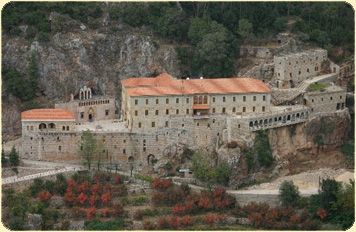
After going through Patriarch Dargham el-Khazen’s personal life and on the path that led him to becoming a Maronite Patriarch, we will display now the list of events that occurred during his era and the achievements he has done.
Aside from being a highly respected and loved Patriarch, there are three headlines that summarize his years as a Patriarch.
– Founding Aintoura School
– Founding Zghorta School
– The Lebanese Synod.
Before we start with the Aintoura School, it is important to mention that given Patriarch Dargham’s and el-Khazen family’s good relationships with French Kings, France’s King Louis XV renewed on the 12th of April 1734, the pact under which France vows to protect and defend Maronites of Lebanon. This pact dates back from 1249 when King Louis IX came to Cyprus, Syria and Lebanon.
Ainoutra School

In 1652, a group of Jesuit monks traveled to Lebanon to preach Christianity. Upon their arrival on a beach on Keserwan’s coast, they were taken by locals for thieves and were consequently arrested and dragged to Sheikh Abi Nawfal el Khazen’s residence. Once they revealed their identity to Sheikh Abi Nawfal as being Jesuit Missionaries, he apologized to them and gave them a warm welcome. Later on, he offered them a piece of land in Aintoura and ordered his men to initiate the construction of a house and temple to facilitate their work and provide them with all the necessary needs.
In 1734, Patriarch Youssef Dargham el Khazen blessed a historical agreement between the Jesuit fathers and the Maronite Church aimed at setting general guidelines for operating Aintoura School.
The purpose of this agreement signed on the 27th of February was to ensure Aintoura school students were receiving a proper Christian Maronite education, and that Maronite students were receiving equal treatment with other non-Maronites. This document helped preserve the origins of the Maronite culture and spread its culture and the Lebanese culture in catholic schools.
Zghorta School:

Another school that came to existence under Patriarch Youssef Dargham el-Khazen’s patronage was the Zghorta School that was founded by Bishop Gerges Banimeen of Ehden and handed to the Jesuit fathers since they were more knowledgeable and educated than locals. Similarly to Aintoura’s school, and in order to strengthen the Maronite roots of this school, it was agreed that students should be taught the Syriac language as well as enlightened on the Maronites’ Syriac and Arabic origins and cultures. Moreover, Jesuits were to preach every Sunday and on Christian holidays to the people and offer religious teachings when possible.
Lebanese Synod
The Lebanese Synod took place in 1736 during Patriarch Dargham el-Khazen’s rule and was a major turning point in the history of the Maronites in Lebanon. It was different from the Maronite synod whereas it paved the way for more legislation and reforms and was more open to suggestions and opinions. Despite its positives, it posed a threat to the Patriarch’s authority and caused controversy and disagreement within the Maronite Church.
Nevertheless, this synod has distinguished the Maronite Church from other Catholic Churches in the region and in the world, and has served as a role model for others to follow.
Given the length of documents and opinions on this matter and its complexity, we will discuss it in a separate article and elaborate on the stances Patriarch Dargham el-Khazen took vis-à-vis this synod.



